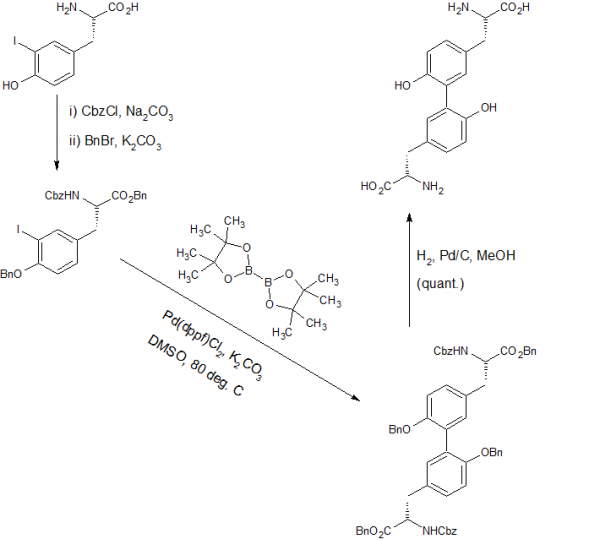Difference between revisions of "Investigating the Organic Synthesis of Dityrosine"
| Line 14: | Line 14: | ||
| + | |||
| + | The starting molecule is 3-iodo-L-tyrosine. This compound is reacted first with benzyl chloroformate and sodium carbonate followed by benzyl bromide and potassium carbonate. This step adds three protecting groups to the molecule. After the protecting groups have been added, this protected intermediate is ready to undergo a Suzuki coupling reaction, which creates a bond between the two aromatic rings. This is accomplished using the suzuki reagent, bis-pinacolato diboron. Once the coupling is complete, the molecule is deprotected using palladium on charcoal and hydrogen, yielding the final molecule of dityrosine. Chromatography is done in between each step to purify intermediates and the final product. | ||
==References== | ==References== | ||
Revision as of 23:07, 4 December 2020
You have reached the page dedicated to research investigating an efficient organic synthesis of the dityrosine molecule. This research is carried out by Monmouth College undergraduate Katelyn Richter under the supervision of Dr. Bradley Sturgeon.
Introduction
New interest in peptides and proteins containing cross-linked dityrosine residues is increasing due to fascinating biological properties they have. Dityrosine is the dimerized form of the amino acid L-tyrosine. Some examples of said biological properties include increased stabilization of structures, conformational restriction of cyclic peptides, and variation in the electronic properties seen in enzyme active sites.[1] The possibilities of application in biological systems make tyrosine dimers a molecule of great intrigue. Dityrosine cross-linking also has a plethora of applications in the realm of biomaterials that mimic cellular environments with great potential for developing ground-breaking techniques in regenerative medicine and tissue engineering.[2] Dityrosine research also provides great insight into the progression of Alzheimer’s disease, which can be defined as the aggregation of insoluble amyloid plaques in the neuropil composed of highly stable, self-assembled Amyloid-beta42 fibrils, the neurotoxic dimerization of which is a direct result of dityrosine cross-linking.[3] These are just a few examples of the vast number of applications dityrosine has, illustrating why it is certainly a molecule worth researching. However, dityrosine is quite expensive. Therefore, in order to test dityrosine and dityrosine derivatives for biological applications, it is much more financially feasible and good laboratory experience for undergraduate researchers to synthesize it themselves.
Synthesis
Below is the proposed synthesis for dityrosine[4]:
The starting molecule is 3-iodo-L-tyrosine. This compound is reacted first with benzyl chloroformate and sodium carbonate followed by benzyl bromide and potassium carbonate. This step adds three protecting groups to the molecule. After the protecting groups have been added, this protected intermediate is ready to undergo a Suzuki coupling reaction, which creates a bond between the two aromatic rings. This is accomplished using the suzuki reagent, bis-pinacolato diboron. Once the coupling is complete, the molecule is deprotected using palladium on charcoal and hydrogen, yielding the final molecule of dityrosine. Chromatography is done in between each step to purify intermediates and the final product.
References
1. Synthesis of the side chain cross-linked tyrosine oligomers dityrosine, trityrosine, and pulcherosine
Ojia Skaff, Katrina A. Jolliffe, and Craig A. Hutton, The Journal of Organic Chemistry 2005 70 (18), 7353-7363, DOI: 10.1021/jo051076m
2. Dityrosine cross-linking in designing biomaterials
Benjamin P. Partlow, Matthew B. Applegate, Fiorenzo G. Omenetto, and David L. Kaplan, ACS Biomaterials Science & Engineering 2016 2 (12), 2 108-2121, DOI: 10.1021/acsbiomaterials.6b00454
3. A central role for dityrosine crosslinking of Amyloid-β in Alzheimer’s disease
Youssra K. Al-Hilaly et al., PubMed 2013, DOI: 10.1186/2051-5960-1-83
4. Synthesis of the side chain cross-linked tyrosine oligomers dityrosine, trityrosine, and pulcherosine
Ojia Skaff, Katrina A. Jolliffe, and Craig A. Hutton, The Journal of Organic Chemistry 2005 70 (18), 7353-7363, DOI: 10.1021/jo051076m
